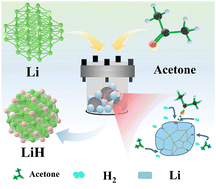Themed collection Carbon Neutrality – Youth Innovation Promotion Association Forum of the Chinese Academy of Sciences

Machine learning integrated photocatalysis: progress and challenges
By integrating machine learning with automation and robots, accelerated discovery of photocatalysts in the future could be envisioned.

Chem. Commun., 2023,59, 5795-5806
https://doi.org/10.1039/D3CC00989K
Bifunctional CoFe/HZSM-5 catalysts orient CO2 hydrogenation towards liquid hydrocarbons
This study explores the hydrogenation of CO2 into liquid hydrocarbons using a CoFe/HZSM-5 tandem catalyst, with insights into the role of synergetic efficiency in enhanced selectivity.

Chem. Commun., 2023,59, 13767-13770
https://doi.org/10.1039/D3CC04409B
Inside-out regulation of MnO toward fast reaction kinetics in aqueous zinc ion batteries
An “inside-out regulation” strategy is employed to improve the Zn2+ reaction kinetics of MnO by Ni doping and graphene wrapping.

Chem. Commun., 2023,59, 12601-12604
https://doi.org/10.1039/D3CC03908K
Constructing layer-by-layer self-assembly MoS2/C nanomaterials by a one-step hydrothermal method for catalytic hydrogenation of phenanthrene
The layer-by-layer MoS2/C catalyst is constructed by the electrostatic adsorption between MoS2 and C nuclei with one-step hydrothermal method, and exhibits an enhanced catalytic hydrogenation activity.

Chem. Commun., 2023,59, 10765-10768
https://doi.org/10.1039/D3CC03306F
Highly selective conversion of CO2 to para-xylene over tandem catalysts
SiO2 and MgO modification on ZSM-5 significantly improves the para-xylene selectivity of the CO2 hydrogenation reaction on the ZnZrO/ZSM-5 catalyst.

Chem. Commun., 2023,59, 7607-7610
https://doi.org/10.1039/D3CC01259J
An acid-alkaline furfural hybrid battery for furoate and bipolar hydrogen production
This work develops an acid-alkaline furfural hybrid battery that can simultaneously achieve electricity output and bipolar hydrogen production, as well as furoate synthesis by effectively utilizing electrochemical neutralization energy.

Chem. Commun., 2023,59, 6837-6840
https://doi.org/10.1039/D3CC00936J
Enhanced interface stability of ammine magnesium borohydride by in situ decoration of MgBr2·2NH3 nanoparticles
The in situ decoration of MgBr2·2NH3 nanoparticles with an average size of 3.7 nm on the surface of Mg(BH4)2·1.9NH3 offers long-term stability towards the Mg metal anode.

Chem. Commun., 2023,59, 6726-6729
https://doi.org/10.1039/D3CC00994G
TiFeNb10O29−δ anode for high-power and durable lithium-ion batteries
TiFeNb10O29−δ has a Wadsley–Roth shear polycrystalline structure with larger lattice parameter and more defects, leading to improved e−/Li+ conductivity and a greater pseudocapacitance contribution. It achieves excellent electrochemical performance.

Chem. Commun., 2023,59, 6710-6713
https://doi.org/10.1039/D3CC00678F
From waste plastics to layered porous nitrogen-doped carbon materials with excellent HER performance
Layered porous nitrogen-doped carbon sheets prepared from waste plastics are employed as an excellent HER catalyst under alkaline conditions.

Chem. Commun., 2023,59, 6187-6190
https://doi.org/10.1039/D3CC01348K
High-performance fiber-shaped Li-ion battery enabled by a surface-reinforced self-supporting electrode
Herein, we develop a surface-reinforced self-supporting fiber electrode via the simple-yet-reliable ink-extrusion technology to introduce a thin polymer layer at the electrode surface.

Chem. Commun., 2023,59, 6064-6067
https://doi.org/10.1039/D3CC00976A
Catalyst-free synthesis of lithium hydride at room temperature
An organic solvent-assisted catalyst-free mechanochemical reaction is developed to synthesize high purity (>98%) lithium hydride at room temperature and low H2 pressure.

Chem. Commun., 2023,59, 2660-2663
https://doi.org/10.1039/D2CC06849D
About this collection
Following the YIPA Youth Forum on Carbon Neutrality: Integrated Development of Multi-energies, this collection will focus on collecting research into the energy technology revolution, including the high-efficiency utilization of fossil energy, development of renewable energy, and multi-energy integration.
Guest Edited by Fengtao Fan, Dalian Institute of Chemical Physics (DICP), Chinese Academy of Science (CAS), this collection features contributions in the fields of clean energy storage and utilization, the conversion and utilization of CO2 and bio-energy, and artificial intelligence (Al) in carbon emission control, among others, we aim to share the latest progress in carbon emission control and carbon neutrality, as well as showcase new ideas on combined clean, low-carbon, safe, and efficient energy systems.